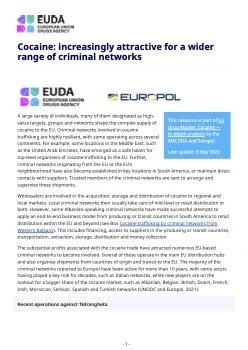By Mark Galeotti
In May 2022, Lithuanian police raided two underground factories where counterfeit cigarettes worth some €73 million were being produced.2 This happens all the time, and even the involvement of a Russian-linked organized crime group was hardly unusual. However, as the investigation extended to Belgium (where the goods would be transhipped to Britain), it became clear that behind the gangsters lay Russian intelligence officers, who were using the business – or at least part of its profits – to raise operational funds for their activities in Europe. With Putin regarding himself as ‘at war’ with the West, at a time when Europol chief Catherine de Bolle is warning that organized crime is on the rise across Europe,3 and Thomas Haldenwang, head of Germany’s counter-intelligence agency, is assessing ‘the risk of [Russian] state-controlled acts of sabotage to be significantly increased’,4 it is perhaps unsurprising that gangsters and spies would find themselves brought together in his campaign. It has, after all, become commonplace since the full-scale invasion of Ukraine in February 2022 to characterize the relationship between Russia and the West as some shade of war: economic, political, but typically more than just cold. Indeed, even as he insists that his invasion is not a war, just a ‘special military operation’ (SVO) – actually calling it a ‘war’ can conceivably get Russians a 15-year prison sentence5 – Putin freely uses the term when describing his country’s engagement with the West. However, it is less clearly understood just how significant and long held this view of his may be. In this context, it does seem in hindsight that Putin has considered himself as de facto at war with the West – or, more precisely, that the West has been warring against him – since at least around 2012. After stepping back from the presidency to the position of prime minister in order to observe the letter, if not the spirit, of term limits, all the while clearly still running the country, when Putin announced he would be returning to the Kremlin, this was for many the last straw. Demonstrations that became known as the Bolotnaya Protests were mastered and dispersed, but Putin seems to have been unable or unwilling to accept that they were a genuine, organic expression of dismay. Instead, he chose to see them as spurred by the US Department of State, after then-Secretary of State Hillary Clinton ‘gave the signal’ to opposition leaders.6 There had been a growing school of thought within Russian security circles that the West was using ‘political technologies’ to topple hostile governments, and support for civil society, democratization and the rule of law were seen as part of this campaign. As a former Kremlin insider put it, Putin was scared, then angry. As far as he was concerned, this was it, this was a sign that the West – the Americans – were coming for him. So he was determined to fight back, and that didn’t just mean defending himself, the repressions and arrests, it meant going on the attack. He was clear, he made it clear to us all: if the West was coming to mess with him, we would mess them up worse, by whatever means necessary.
Russia’s transition from a “conscription state” to a full “mobilization state”, after the 2022 invasion of Ukraine, has intensified the involvement of criminal groups in operations tied to sanctions-busting, cyber warfare, and intelligence. Organized crime networks provide Russia with access to restricted goods, such as advanced electronics for its military, and facilitate money laundering and illegal financial flows. Notably, Russian intelligence services have relied on criminal syndicates to supplement their espionage activities, including sabotage, cyberattacks, and assassinations.
The report also highlights Russia’s weaponization of migration, using smuggling networks to create political instability across Europe. Meanwhile, Putin’s regime has blurred the lines between state and criminal actors, using them as tools to evade international sanctions and expand Russian influence globally.
“Gangsters at War” reveals how Russian-based organized crime operates as a tool of Kremlin foreign policy, focusing not just on profits but on weakening geopolitical rivals. From sanctions evasion to destabilizing societies, criminal networks have become a key element in Russia’s geopolitical arsenal. The report calls for increased vigilance, international cooperation, and stronger countermeasures to address this growing threat to global stability
Geneva: Global Initiative Against Transnational Organized Crime.2024. 62p.





















